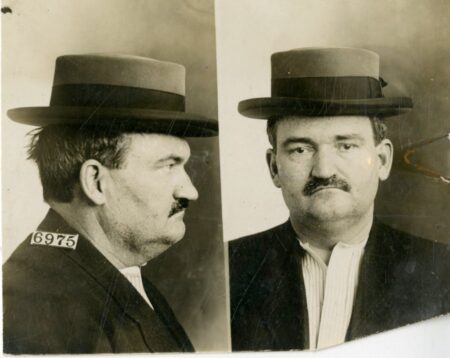John Mabray’s Gambling Ring
During March 1910, the United States Attorney General in Council Bluffs, Iowa charged John C. Mabray (a version of his actual name, Mabry) and a dozen defendants with using the mail to commit gambling fraud in professional boxing, professional wrestling, and professional horse racing.
Mabry, a livestock dealer living in Kansas City, Missouri, employed insiders in boxing, wrestling, and horse racing to defraud gamblers of $2,000 to $37,000. $37,000 is over a million dollars in 2024.

Mugshot of John C. Mabry aka Mabray, who ran a boxing, wrestling, and horse racing gambling ring (Public Domain)
Mabry led a “millionaire’s club” of gamblers working in New Orleans, Colorado, and Council Bluffs, Iowa. Mabry used professional wrestlers and manager to steer gamblers into big losses on predetermined wrestling matches. Thomas Gay, a professional wrestler from Streator, Illinois, met Mabry in New Orleans.
Gay testified against Mabry for leniency in his own case. Gay testified that Gay convinced James Tierney, also of Streator, Illinois, to bet $10,000 on a “sure thing wrestling match.” Tierney lost the $10,000 bet, when Tierney’s opponent told the referee he could not continue. Mabry gave Gay $2,500 of the $10,000 bet.
Ernest Fenby, a journeyman professional wrestler, also testified to Mabry’s operation. Mabry sent instructions to his confederates through the mail, which is why Mabry and his conspirators ended up in federal prison. You cannot use the U.S. mail to defraud citizens even if the citizens are taking part in illegal gambling.
Mabry sent Fenby, of Sheperd, Michigan, instructions by mail about a series of worked wrestling matches. Fenby and his accomplice, James Coon, induced three acquaintances to put $14,000 down on a match. Fenby and Coon assured the men that Fenby would lose the match on purpose.
Fenby said his opponent would have a balloon or other bladder instrument to hold blood in the opponent’s mouth. The opponent bit down and released the blood during the match. It looked like Fenby’s opponent was suffering internal bleeding forcing the referee to award the match to Fenby. Fenby told the court that he and his opponent pulled this trick on three separate occasions.
What surprised me about this case is the large amount of money the victims were willing to wager on no-name wrestlers. The victims thought they had inside information and greed led the victims to gamble far more money than they should. $10,000, the most common bet, is $317,000 in 2024 dollars.
The government built a convincing case. The judge sentenced Mabry and eight of his co-defendants to two years in federal prison along with a $10,000 fine.
The judge sentenced “Ole” Marsh, the future manager of Marin Plestina, and one other defendant, who pleaded guilty, to fourteen months in federal prison and a $1,500 fine. Most defendants, including Mabry, served fourteen months or less.
The Mabry gang made headlines across the country in 1909 and 1910. As late as 1916, newspaper reporters were trying to track down John Mabry for a story about the scheme. The newspapers never found Mabry, who lived in Kansas City, Missouri, and retired from the gambling profession.
The public’s attention span is short though. By the 1920s, people had forgotten John Mabry and his gambling schemes. Now, promoters manipulated the gambling not gambling rings.
You can leave a comment or ask a question about this or any post on my Facebook page.
Sources: Sioux City Journal (Sioux City, IA), March 11, 1910, p. 2, Sioux City Journal, March 13, 1910, p. 3 and The Evening Nonpareil (Council Bluffs, IA), March 21, 1910, p. 1
Pin It
